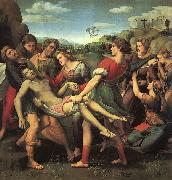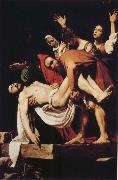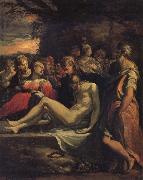
Oil On
Canvas, Real Flavor of Old Masters
|
Raphael
|
|||
|
|
|||
| Italian High Renaissance Painter, 1483-1520 Raphael Sanzio, usually known by his first name alone (in Italian Raffaello) (April 6 or March 28, 1483 ?C April 6, 1520), was an Italian painter and architect of the High Renaissance, celebrated for the perfection and grace of his paintings and drawings. Together with Michelangelo and Leonardo da Vinci, he forms the traditional trinity of great masters of that period. Raphael was enormously productive, running an unusually large workshop, and, despite his early death at thirty-seven, a large body of his work remains, especially in the Vatican, whose frescoed Raphael Rooms were the central, and the largest, work of his career, although unfinished at his death. After his early years in Rome, much of his work was designed by him and executed largely by the workshop from his drawings, with considerable loss of quality. He was extremely influential in his lifetime, though outside Rome his work was mostly known from his collaborative printmaking. After his death, the influence of his great rival Michelangelo was more widespread until the 18th and 19th centuries, when Raphael's more serene and harmonious qualities were again regarded as the highest models. His career falls naturally into three phases and three styles, first described by Giorgio Vasari: his early years in Umbria, then a period of about four years (from 1504-1508) absorbing the artistic traditions of Florence, followed by his last hectic and triumphant twelve years in Rome, working for two Popes and their close associates. | |||
|
|
|||
|
|
The Entombment Raphael21.jpg Painting ID:: 3302 Visit European Gallery |
Galleria Borghese, Rome | |
Height Width |
INS/CM |
||
|
X |
|
||
|
|
|||
|
Caravaggio
|
|||
|
|
|||
| Italian Baroque Era Painter, ca.1571-1610 Italian painter. After an early career as a painter of portraits, still-life and genre scenes he became the most persuasive religious painter of his time. His bold, naturalistic style, which emphasized the common humanity of the apostles and martyrs, flattered the aspirations of the Counter-Reformation Church, while his vivid chiaroscuro enhanced both three-dimensionality and drama, as well as evoking the mystery of the faith. He followed a militantly realist agenda, rejecting both Mannerism and the classicizing naturalism of his main rival, Annibale Carracci. In the first 30 years of the 17th century his naturalistic ambitions and revolutionary artistic procedures attracted a large following from all over Europe. | |||
|
|
|||
|
|
The Entombment new9/Caravaggio-937835.jpg Painting ID:: 33574 Visit European Gallery |
mk86 c.1602-1604 Oil on canvas 300x203cm Rome,Musei Vaticani,Pinacoteca Vaticana | |
Height Width |
INS/CM |
||
|
X |
|
||
|
|
|||
|
PARMIGIANINO
|
|||
|
|
|||
| Italian Mannerist Painter, 1503-1540 Italian painter, draughtsman and printmaker. Beginning a career that was to last only two decades, he moved from precocious success in the shadow of Correggio in Parma to be hailed in the Rome of Clement VII as Raphael reborn. There he executed few large-scale works but was introduced to printmaking. After the Sack of Rome in 1527, he returned to northern Italy, where in his final decade he created some of his most markedly Mannerist works. Equally gifted as a painter of small panels and large-scale frescoes both sacred and profane, he was also one of the most penetrating portrait painters of his age. | |||
|
|
|||
|
|
The Entombment new10/PARMIGIANINO-253353.jpg Painting ID:: 34264 Visit European Gallery |
mk91 ca.1523 Oil on canvas transferred from a panel 32x26.5 | |
Height Width |
INS/CM |
||
|
X |
|
||
|
|
|||
|
unknow artist
|
|||
|
|
|||
|
|
|||
|
|
The Entombment new16/unknow artist-794875.jpg Painting ID:: 40975 Visit European Gallery |
mk159 1480s Tempera and oil on panel 94x182cm | |
Height Width |
INS/CM |
||
|
X |
|
||
|
|
|||










